NCERT Solutions for Class 7 Science Chapter 17 Forests: Our Lifeline
NCERT Solutions for CBSE Class 7 Science Chapter 17 Forests Our Lifeline are given below. These solutions help students to clear their doubts and to obtain good marks in final exam. Class 7 Science NCERT questions and answers provided in this article are strictly based on the CBSE syllabus and curriculum.
Class 7 Science Chapter 17 Forests Our Lifeline NCERT Solutions
Class 7 NCERT Solutions for Science Chapter 17 includes all the intext and exercise questions. All these questions are solved by experts with a detailed explanation that will help students complete their assignments and homework.
EXERCISES
Question 1: Explain how animals dwelling in the forest help it grow and regenerate.
Answer: Various types of animals (herbivores, carnivores, omnivores) live in forests and contribute to food chain. Following activities show how animals help forest grow and regenerate.
- Animals help in dispersal of seeds from one part of the forest to other part.
- Animal’s excreta and their dead bodies when decomposed into soil act as manure for the plants.
- Microorganisms convert dead plants and leaves into humus which is rich in nutrients. Humus in soil provide necessary minerals for plant growth.
Question 2: Explain how forests prevent floods.
Answer: Forest acts as a natural absorber of rainwater and allows it to seep. When rainwater falls on leaves of trees and plants, it does not fall directly on the ground. It drips slowly on the forest ground (does not stagnate) and hence prevent floods.
Question 3: What are decomposers? Name any two of them. What do they do in the forest?
Answer: The micro-organisms which convert the dead plants and animals to humus are known as decomposers.
Examples: Fungi and Bacteria.
Decomposers recycle and convert the dead matter into humus which mixes with forest soil and provide necessary nutrients to plants. Thus decomposers help in maintaining the necessary nutrient balance in the soil.
Question 4: Explain the role of forest in maintaining the balance between oxygen and carbon dioxide in the atmosphere.
Answer: Plants release oxygen in the atmosphere during the process of photosynthesis. This oxygen is inhaled by the animals for respiration. During respiration, they release carbon-dioxide which is absorbed by plants. In this way the oxygen and carbon dioxide cycle goes on. Since forests contain a large number of plants, they help much in this cycle and maintain balance in nature.
Question 5: Explain why there is no waste in a forest.
Answer: Forests are excellent, perfect and natural recycling factories. All animals, whether herbivores or carnivores, depend ultimately on plants for food. Herbivores eat plants and their products. Carnivores eat herbivores. Dead remains of animals and plants are decomposed by micro-organisms into humus. Whatever is produced in the forest is ultimately utilized by different components of the forest. Forests maintain a network of food chains called food web and hence nothing goes waste in a forest.
Question 6: List five products we get from forests?
Answer: (i) We get medicines from forests.
(ii) We get gum from forests.
(iii) We get wood which is used for many purposes like making furniture, paper etc.
(iv) We get food for animals from forests.
(v) We get sealing wax from forests.
Question 7: Fill in the blank:
(a) The insects, butterflies, honeybees and birds help flowering plants in _______.
(b) A forest is a purifier of _______ and ________.
(c) Herbs form the ________ layer in the forest.
(d) The decaying leaves and animal droppings in a forest enrich the _______.
Answer: (a) The insects, butterflies, honeybees and birds help flowering plants in pollination.
(b) A forest is a purifier of air and water.
(c) Herbs form the lowest layer in the forest.
(d) The decaying leaves and animal droppings in a forest enrich the soil.
Question 8: Why should we worry about the conditions and issues related to forests far from us?
Answer: Forests are very important resources. We should be careful and concerned about the issues related to forest due to following reasons:
- If there are no forests, there would be more floods and more soil erosion.
- Forests affect the global environment in a great way. For example; reduced forest cover in a particular area leads to global warming which affects the whole earth.
- Forests are the dwelling of many animals. Deforestation will endanger our life and environment.
- In the absence of trees and plants, the animals will not get food and shelter.
- Forests provide us large number of useful products including wood, fruits and medicines. These products would not be available in the absence of trees and plants.
Question 9: Explain why there is a need of variety of animals and plants in a forest.
Answer: A greater variety of plants and animals in the forests helps it to regenerate and grow. Greater variety of plants means more food and habitat for the herbivores. An increase in herbivores means more food for carnivores. Decomposers help to maintain the supply of nutrients to the soil and to the growing plants. This wide variety makes forest a dynamic living entity.
Question 10: In Fig. 17.15, the artist has forgotten to put the labels and directions on the arrows. Mark the directions on the arrows and label the diagram using the following labels:
Clouds, rain, atmosphere, carbon dioxide, oxygen, plants, animals, soil, roots, water table.

Answer:

Question 11: Which of the following is not a forest product?
(i) Gum
(ii) Plywood
(iii) Sealing wax
(iv) Kerosene
Answer: (iv) Kerosene
Question 12: Which of the following statements is not correct?
(i) Forests protect the soil from erosion.
(ii) Plants and animals in a forest are not dependent on one another.
(iii) Forests influence the climate and water cycle.
(iv) Soil helps forests to grow and regenerate.
Answer: (ii) Plants and animals in a forest are not dependent on one another.
Question 13: Micro-organisms act upon the dead plants to produce
(i) sand
(ii) mushrooms
(iii) humus
(iv) wood
Answer: (iii) humus